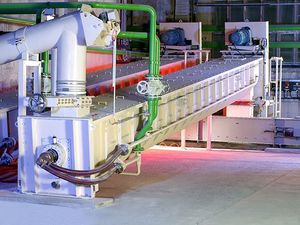Difference between revisions of "Heating Screws"
Jump to navigation
Jump to search
(Created page with "Category:Screw Conveying{{Knoppen}} <noinclude><!------------------------------------------------ * READ THIS FIRST * Only edit this page if you can improve the content. * I...") |
|||
| Line 7: | Line 7: | ||
* Please start editing this page after the /noinclude | * Please start editing this page after the /noinclude | ||
* -------------------------------------------------></noinclude> | * -------------------------------------------------></noinclude> | ||
[[File:Heating screws2.jpg|thumb|right|Heating Screws]] | |||
'''Heating Screws''' transfer heat through contact with an external jacket (bolt-on or integral), and/or through the transfer [[Augers]] itself. The material is heated or cooled while being tranferred down the length of the [[Conveyors]]. In the case of a hollow flight auger, the flights themselves aid in heat transfer. To accomplish this, a variety of heating or cooling media may be used.Heat transfer takes place via screw shaft, jacket, flights or a combination of all. | |||
==Advantages== | |||
* Designs for high pressure applications meet the requirements of the ASME Boiler and Pressure Vessel Code. | |||
* Cost savings as the thermal treatment is accomplished in the same time as product is conveyed. | |||
* Accurate control of thermal treatment time. | |||
* Control of temperature during material transfer. | |||
* Greater heat transfer surface area per unit of product than batch mixer systems. | |||
* In-house testing available | |||
==Applications== | |||
* Drying | |||
* Polymerization | |||
* Heat curing | |||
* Cooling/freezing | |||
* Microbial kill | |||
* Sintering/calcining | |||
Latest revision as of 00:50, 27 August 2012
Heating Screws transfer heat through contact with an external jacket (bolt-on or integral), and/or through the transfer Augers itself. The material is heated or cooled while being tranferred down the length of the Conveyors. In the case of a hollow flight auger, the flights themselves aid in heat transfer. To accomplish this, a variety of heating or cooling media may be used.Heat transfer takes place via screw shaft, jacket, flights or a combination of all.
Advantages
- Designs for high pressure applications meet the requirements of the ASME Boiler and Pressure Vessel Code.
- Cost savings as the thermal treatment is accomplished in the same time as product is conveyed.
- Accurate control of thermal treatment time.
- Control of temperature during material transfer.
- Greater heat transfer surface area per unit of product than batch mixer systems.
- In-house testing available
Applications
- Drying
- Polymerization
- Heat curing
- Cooling/freezing
- Microbial kill
- Sintering/calcining
